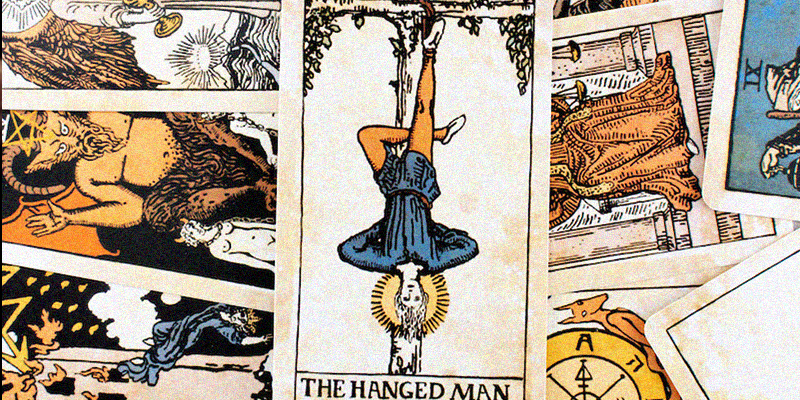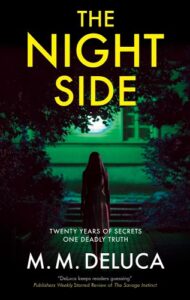I never met my paternal grandmother. She died before I was born, but from a few family photos, I formed a picture of a smartly turned-out woman with warm brown eyes, a wavy, blunt-cut bob and a weakness for silk scarves. Deeply respected in her small north-eastern England mining town, she was a pillar of the local spiritualist church.
My dad told three stories related to her. As a child, he sat in on their seances. In gloomy, candlelit community halls, he’d sit by the door. His mother, my grandmother, hands linked with the other believers, sat around a table. A candle flickered and shadows made odd shapes on the walls, but my father stayed still and silent even when she called for a sign from the other side. Even when the table began to thump and no one appeared to be moving it. He always claimed he was never afraid when his mother tried to contact the wandering spirits of lost loved ones to help assuage the grief of those recently bereaved.
Later, in his teens my father had a sweetheart. Tragically her dress caught fire and she was critically injured. She asked for him in her dying moments to come to her bedside. Weeks later at choir practice, she appeared to him in Durham cathedral. A spectral figure saying a last goodbye.
Some years later my mother was at home alone one night and sensed the undeniable feeling that her mother-in-law was standing behind her in the room, but she couldn’t bring herself to turn and look. When my father came home, he told her his mother had died that very night at the exact time my mother sensed the spiritual presence.
These three stories are all linked to my grandmother. Enough evidence to convince me that Hamlet may have been onto something when he said to Horatio: “There are more things in heaven and earth…than are dreamt of in our philosophy.”
Maybe.
I still retain some scepticism. There is no coming back from the other side. Houdini vowed he would, but I don’t think he made it.
But maybe…
It’s this sentiment that provided inspiration for my upcoming novel, The Night Side. The story is about Ruby Carlson who, at eighteen, ran away from her home in Stoneybrook, Montana, and vowed she’d never return. Never return to life under the control of her manipulative mother, Ida, a self-styled medium and psychic scammer who made a career out of ruining people’s lives. Never return to the small town where enemies lurk at every turn.
But now, twenty years later, Ruby is back. Her mother is missing, presumed dead, and Ruby reluctantly returns to a home filled with chilling memories to settle Ida’s affairs. Did she really commit suicide by drowning, or is this another dark scheme? Ruby thought she knew everything about her mother, but finds herself unraveling a web of lies and secrets to reveal a story more twisted than anyone could have imagined . . .
In this book, I wanted to explore the darker side of the psychic business. I researched many articles about private detectives who, much like Sir Arthur Conan Doyle in the late 19th and early 20th centuries had made it their business to root out fake mediums and psychics and expose their trickery.
These con artists are experts at rooting out their vulnerable and emotionally fragile victims, who grasp onto any vestige of hope. Who want to believe the so-called “magic” of the trickster who proceeds to take over their lives, manipulating them and taking them for every penny they possess.
It’s no surprise there are plenty of great books out there that feature mediums and the mysteries of the spirit world. Here are a few great examples:
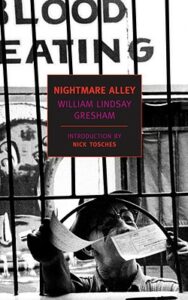
Nightmare Alley by William Lindsey Gresham
This classic American noir story, cleverly constructed around the twenty-four arcana of the Tarot, begins when Stanton Carlisle, employed as a carny at a travelling circus watches their freak-show geek – an abject alcoholic, and the pathetic object of the voyeuristic crowd’s gleeful disgust and derision. He’s young, ambitious and incredulous that a man could fall so low. He makes a vow that no way in hell, anything like that will ever happen to him.
A quick learner with a ruthless streak, he teams up with a beautiful but vulnerable woman as part of a double act in which he mesmerises her. Stan soon leaves his circus days behind him, becoming a successful spiritualist who exploits the weak and the wealthy. His primary mantra becomes, “Nothing matters in this goddam lunatic asylum of a world but dough,’ and like all sneaky grifters, Carlisle believes he understands the basest motives of humans and what drives them and so he is determined to ‘Find out what people are afraid of and sell it back to them.’
He becomes a callous manipulator who uses anyone and everyone to claw his way to the top, and at the height of his newfound fame and fortune begins to view himself as immortal, declaring over a glass of the finest liquor that, ‘The rest of them drink something else: they drink promises. They drink hope. And I’ve got it to hand them.’ But, as in all great tragedies, pride comes before a dizzying fall from grace and Gresham’s stark, brutal imagery captures every agonizing facet of Carlisle’s fate.
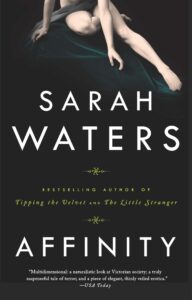
Affinity by Sarah Waters
In this masterful Victorian Gothic chiller, Margaret Prior, an upper-class woman recovering from a suicide attempt, has begun visiting the women’s ward of London’s grim and forbidding Millbank prison, as part of her rehabilitative charity work. Amongst Millbank’s murderers and common thieves, Margaret finds herself increasingly fascinated by an apparently innocent inmate, the mysteriously charismatic spiritualist Selina Dawes. Selina was imprisoned after a séance she was conducting went horribly awry, leaving an elderly matron dead and a young woman deeply disturbed. Although initially skeptical of Selina’s gifts, Margaret is soon drawn into a twilight world of ghosts and shadows, unruly spirits and unseemly passions, until she is at last driven to concoct a desperate plot to secure Selina’s freedom, and her own. The brilliant Sarah Waters makes this a visceral and terrifying story of passion, manipulation and deception.
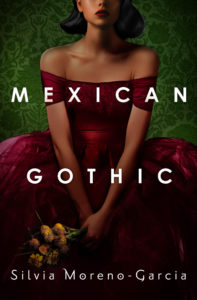
Mexican Gothic by Silvia Moreno-Garcia
“There’re people in the walls,” Catalina says. “There’re people and there’re voices. I see them sometimes, the people in the walls. They’re dead.”
This chilling, atmospheric feminist thriller by the brilliant Silvia Moreno-Garcia plays cleverly with all the tropes of a Gothic domestic-noir: a decaying and apparently haunted Victorian mansion in a post-colonial burned-out mining town, exploited for years by English silver barons, a plucky heroine who comes to rescue her ailing cousin, held virtually captive by her oppressive husband, a dark and terrifying secret just waiting to be uncovered.
Noemí, the main protagonist is an unlikely rescuer: She’s a glamorous debutante, and her chic gowns and perfect red lipstick are more suited for cocktail parties than amateur sleuthing. But she’s also tough and smart, with an indomitable will, and she is not afraid: Not of her cousin’s new husband, who is both menacing and alluring; not of his father, the ancient patriarch who seems to be fascinated by Noemí; and not even of the house itself, which begins to invade Noemi’s dreams with visions of blood and doom.
Her only ally in this inhospitable abode is the family’s youngest son. Shy and gentle, he seems to want to help Noemí, but might also be hiding dark knowledge of his family’s past. For there are many secrets behind the walls of High Place. The family’s once colossal wealth and faded mining empire kept them from prying eyes, but as Noemí digs deeper she unearths stories of violence and madness. And Noemí, mesmerized by the terrifying yet seductive world of High Place, may soon find it impossible to ever leave this enigmatic house behind (Goodreads).
In its review, the Washington Post rightly calls this “a creepy, intoxicating mystery that’s almost impossible to put down,” but it’s also a chilling indictment of the real-life horrors of eugenics, racism and the plunderous practices of colonialism.
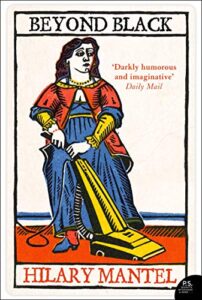
Beyond Black by Hilary Mantel
A darkly comic but sinister tale of wicked spirits and suburban mediums from the late Man Booker Prize-winning author of Wolf Hall, Bring Up the Bodies and The Mirror & the Light. Alison Hart, a medium by trade, tours the dormitory towns of London’s orbital ring road with her flint-hearted sidekick, Colette, passing on messages from beloved dead ancestors. But behind her genial, smiling persona hides a desperate woman whose ability to communicate with spirits is a torment rather than a gift, since her days and nights are haunted by the men she knew in her childhood: thugs and petty criminals who preyed upon her hopeless, addled mother. These nasty, unwelcome spirits gradually infiltrate her body and home, becoming stronger and more persistent the more she resists. The story is told in Mantel’s brilliantly lyrical language with a master writer’s perception of the follies of the human condition.
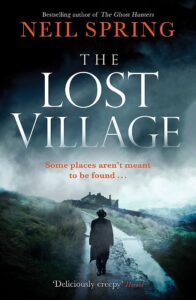
The Lost Village by Neil Spring ((The Ghost Hunters #2)
Described as Agatha Christie meets James Herbert, Neil Spring’s second book in The Ghost Hunter Series is based on real, historic events. It’s a haunting, action-packed thriller set in the remote village of Imber, a hopeless, abandoned place. The outside world hasn’t been let in since soldiers forced the inhabitants out, much to their contempt.
But now, a dark secret threatens all who venture near. Everyone is in danger, and only ghost hunter, Harry Price can help. Reluctantly reunited with his former assistant Sarah Grey, he must unlock the mystery of Imber, and dig up the secrets someone thought were long buried. But will Sarah’s involvement be the undoing of them both? Harry is a sceptic, but with the help of trusted medium and army man, Sidewinder, Sarah and Harry uncover horrors and evidence that practically has Harry convinced that the paranormal and ghosts actually do exist. This spooky, action-packed thriller is a real page-turner with a creepy, evocative setting.
***

